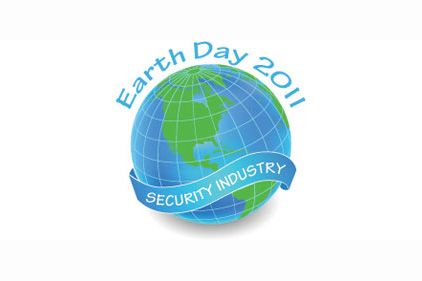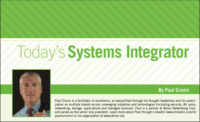SDM had the chance to interview Dr. Bob Banerjee, senior director of Training and Development, NICE Systems, Ra'anana, Israel, recently on “green” initiatives at NICE Systems. Dr. Bob has observed in the video security market that although everyone is cognizant of green issues, there is a need for education on how to make green buying decisions, and how to calculate a payback on those technology investments. The good news, he says, is that going green actually costs less than not going green. Bob explained that one of the biggest goals customers have is reducing overall operating costs, but what many don’t realize is that when it comes to energy consuming components, cutting operating costs is inseparable from going green. There is a direct correlation between using less energy to power and cool equipment, and one’s carbon footprint. So understanding and evaluating operating expenses is important from both financial and ecological standpoints.
One example Banerjee cites to articulate the carbon footprint of security systems is as follows:
Let’s say that a video security system needs five servers and each one needs two RAID disk arrays. Assuming they are modern well-respected brand names, he can calculate that they will consume (for power and cooling) 220,000 kWh over five years, which totals to $28,000 in electricity costs and a cost of 147 tons of CO2 to the planet. Put into perspective your personal carbon footprint for flying from New York to Los Angeles is less than one ton.
Banerjee offered the following example to help demonstrate/calculate the savings that can be generated by more environmentally friendly, efficient systems and offered some questions to ask when considering a decision to change a system.
1. There are many aspects to green initiatives to consider. For example, what green methods are used in fabricating the hardware components? How much power is used to create it? How will you dispose of it? When the product reaches end of life will you throw it in a landfill?
2. NICE focuses on the operation aspect, which affects the operating expenses and the environment. Many organizations recognize and appreciate this, especially government bodies.
3. One underlying question that is worth considering for this interview: “If an old device uses 5 kWh, and a modern one uses 4 kWh, is it worth replacing?” This is an important question because many existing systems are ‘electricity guzzlers.’ They are also typically big and clunky and require more rack space – and there’s a cost associated with that too.
4. For example, many three- to five-year-old video systems are ‘electricity guzzlers’ while more modern systems have benefited from Moore’s law, becoming faster, cheaper and smaller. In your home, when you make personal decisions about replacing older electrical appliances with newer more efficient ones, you might factor in how often you use them. Infrequent use might translate into marginal cost savings – but not so with security systems that operate 24/7. Even small differentials in power consumption can result in huge cost savings.
5. Just by way of example, take a 1kWh device. A 1kWh device uses electricity and generates heat, which in turn requires about a third more power for cooling (assuming modern HVAC). Knowing this simple fact helps us understand the larger implications when we’re talking about security systems that could consume possibly hundreds of thousands of kilowatt-hours over a five year period.
6. To take this one step further, let’s say our 1kWh device above consumes 58,753 kWh over five years —this is slightly more than the average U.S. household (about 50,000). So if that small 1kWh device consumes the same amount of power as your household, just imagine how much electricity a 500-camera system that uses dozens of kilowatt hours would consume over that same time period.
7. Beyond the financial cost, there is a carbon footprint cost for our 1kWh device too. At an average of 1.3 lbs CO2 per kWh (that’s a good average for what power stations produce) a 1kWh device could easily generate 76,000 lbs or 38 tons of CO2 over a five year period.
8. Now back to that question of: “Is it worth upgrading an old device to a modern one to save 1 kWh?” In pure electricity cost (at the U.S. average of 13.3 cents per kWh), 58,753 kWh would save us about $8,000 over five years, again for 1 kWh.
9. Put another way, an investment of $8,000 to save 1 kWh, would have a pay-back period of five years.
10. Now we have the numbers for a savings of 1 kWh, we need to determine what the savings for any new system would be, compared to the ’electricity guzzling’ old system.
11. Imagine if your old system was a stack of eight or 16CH DVRs and external disk arrays with small 250 GB HDDs (which were considered big at the time). Thanks to Moore's Law we can now have 128 cameras and 22TB in a 2RU single box. For a few hundred cameras, the savings are potentially huge. NICE is regularly replacing its customers' DVRs with new recorders, saving three-quarters of the power, and cutting rack space requirements down to one-sixteenth of what they would have been before.
12. Consider a more realistic example: a 15 kWh system being replaced by a 5 kWh system, saving 10 kWh. That is a savings of $80,000 to the CFO and 380 fewer tons of CO2 to the planet. While people used to upgrade equipment to benefit from better functionality, NICE’s customers are also doing it because the savings in operating expenses over five years will pay for a huge chunk of the capital expense.
13. But let’s not forget there is a two-way impact for each kilowatt-hour saved over five years: 38 tons of CO2 equivalent for global warming effect, and $8,000 in savings over the same period.
It is the savings from being green that Banerjee sees as the biggest motivating factor at the moment.
“I have seen people changing their buying behavior, but not as often due to green aspirations as due to pure numbers savings. Government bodies have enormous pressure on them and they seem to consider the environment more frequently. However, the United States is not the world leader in cutting down consumption. We are the biggest consumer of power in the world and the largest maker of CO2in the world.
“At NICE, a natural practice —whenever we do a quote we also have a calculator that shows the operating expenses. The tool shows exactly how much electricity is consumed, the heat that is produced, and amount of space it uses up. Some customers are driven more by rack space, as their rack space might be very limited. Others are driven by the electricity costs. Regardless, we want to give them the information they need to be able to make the most informed decision for their company.
“You may be wondering why this is news now, but not five years ago. It’s because at that time it was all proprietary recorders, evolving very slowly. Now, NICE’s turnkey recorders are based on Dell platforms and our software also runs on other leading IT server platforms —and you can’t beat their rate of evolution. Our job, on the other hand, is to write the best software to utilize those platforms. Essentially, NICE has moved from being a hardware company to a software company that adds value to the video coming in and getting recorded.”




